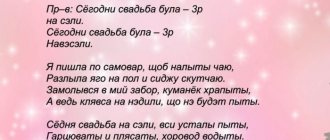The first dance of the newlyweds is an obligatory part of any wedding celebration, a tradition that is observed all over the world.
But many couples no longer want to just “stagger” to the beat of a beautiful slow composition; on the contrary, they approach the issue of staging the first wedding dance with all responsibility. Some people perfect the choreography, some add humor, and some bring to life all the creativity they can muster.
What first dances of newlyweds are popular nowadays?
1
Combined dance with surprise
The first dance of the newlyweds has become very fashionable at a modern wedding, which begins as a classic slow dance, but at a certain moment the music stops, a calm, beautiful melody is replaced by a fiery song, and the bride and groom begin to “have a blast.”
In the case of this version of the first dance, it is important to make a high-quality soundtrack for your performance.
“Chop” pieces of your favorite songs in advance and combine them into one track, so that the DJ only has to include it in the playlist. Otherwise, incidents may arise that will ruin the whole surprise for you.
For example, what happened with this pair:
The main thing in this dance is not only to learn the movements and do them synchronously, energy and expression are important.
Don't be shy, you won't be judged strictly - this is not a choreographic competition. Just relax and enjoy what is happening, otherwise from the outside you may look too stiff and “wooden”.
And smile! A smile is half the success.
5
Choreographer
If a man is much taller than a woman, then the dance elements will look harmonious when the partner moves down while the partner remains standing straight. If the bride is taller than the groom, or they are about the same height, then you can use supports in which the girl leans away and the boy stands straight. If rotation of the partner is planned, then it is advisable for the partner to take her in his arms sideways. Lifts and complex techniques are abandoned if the bride has a thicker physique than the groom.
Maria Stoyanova
The Viennese waltz is chosen by those who have done at least a little choreography, even in childhood, because it requires endurance, flexibility and plasticity. Boston is a slow version of the waltz, which is suitable for reserved and romantic people.
For expressive individuals who never sit still in everyday life, passionate Latin American dances are suitable. In this case, you can choose from the following options.
- Salsa. This dance combines tenderness and passion. This is the fire, emotions and desire that reign between the newlyweds.
- Bachata. The bachata wedding dance routine is similar to salsa, but the movements are more sexy and sensual. Magnetism arises between the partners; they constantly hold hands in a castle so as not to lose the intimacy of the moment.
- Paso Doble. It is a dance with strict movements in which the man plays the role of a bullfighter and the woman imitates the red cloth in his hands, matching his movements.
- Reggaeton. This is a more modern dance, similar to street dance. Each partner shows their flexibility and ability to move, and then they briefly merge into one, demonstrating the passion that arises.
- Rumba. This is a slow and sensual dance, which was originally a wedding dance in Latin America.
- Cha-cha-cha. This is the simplest and most playful dance of the entire Latin American program. This is a dance combination of flirting and intimate dialogue with a partner without the help of words.
Another popular wedding dance is the tango, which has different variations - a strict ballroom style, a passionate Argentinean performance, or a Finnish dance that is unusual in its movements. For future newlyweds, staging a tango wedding dance will require more preparation than a waltz, but with the right attitude and diligence, the dance will turn out spectacular and sensual.
For a couple who wants to emphasize tender and warm feelings in their relationship, a foxtrot may be suitable. This is a romantic and elegant dance, characterized by lightness and elegance, softness, grace and freedom of movement, smoothness and agility. Only after repeated training will the bride and groom be able to make the foxtrot the way it was originally intended.
For a celebration in retro, disco or dude style, you can learn one of the dances that were popular in the last century. It can be energetic boogie-woogie, daring rock and roll, crazy Charleston, etc. Future newlyweds can even learn dances from their favorite films of the last century, including black and white ones.
A popular solution lately is a dance mix, which combines several different dances performed to the appropriate music. For example, first the newlyweds dance a classic waltz, then the composition changes, and they pick each other up in an energetic cha-cha-cha, and then perform a sensual tango.
Complex production involving friends
If you are a couple of professional dancers and the friends invited to your wedding also know how to dance, then you are incredibly lucky!
And be sure to involve your friends - the crowd dances look amazing in the video.
You shouldn’t limit your fantasies regarding wedding dance, because you have access to what many couples can only dream about. Come up with something truly beautiful and spectacular to turn your first dance into a grand show!
Be the most original at your celebration and send us a video of your unusual wedding dance!
Rehearsals
To learn a simple number with smooth repetitive movements, 3-4 lessons will be enough. And this is provided that the couple has good choreographic training. In other cases, the process of staging the first wedding dance will require a lot of time and effort from the partners. Rehearsals should begin immediately after submitting the application - that is, several months before the celebration. Classes should be regular and take place at strict intervals (ideally 2-3 times a week). Long breaks between rehearsals should not be allowed, otherwise the partners will simply forget the movements they have already learned.
Of course, the easiest way to start staging a number is at home. However, the ideal option would be to rent a dance hall by the hour. After all, in a typical city apartment there is simply nowhere to turn around. Carpets and furniture will become a serious hindrance during rehearsals. In addition, the home environment has a relaxing effect on partners. At the first failure, you will be tempted to drop everything and settle into a cozy chair in front of your favorite TV series or go to the refrigerator to enjoy something tasty. In the hall such a problem simply will not arise. Partners will try to spend the time allotted to them with maximum benefit.
Many couples wonder about the selection of dance movements. In searching for an answer, the Internet will be your best ally. Here you can find both professional master classes on staging a number and spectacular dances performed by the newlyweds. It is enough to take a few simple movements as a basis, adapt them to the chosen music and build your own, absolutely unique number. In the absence of proper choreographic preparation, it will be easier to copy a ready-made dance from the Internet. Ideally, each session should be recorded on camera so that partners have the opportunity to work on mistakes.
Rehearsals should take place in the same clothes and shoes in which the young people will perform the first dance. This will allow you to avoid excesses at the most crucial moment. So, if the bride plans to waltz in a fluffy ball gown, she should take a corset and crinoline (skirt with rings) to the rehearsal. The groom should wear, if not a wedding suit, then a suit of a similar cut. If the bride's outfit is complemented by a train, the girl will have to hold it in her hand throughout the entire dance, which should be taken into account both when staging the number and during rehearsals.
Confident Leading
In pair dances, the roles have long been distributed - the partner leads, the lady follows. Accordingly, the partner takes the lady by the hand, and not vice versa (which is often the “sin” of overly emancipated persons).
While performing dance numbers and changing positions, the partner intercepts the lady’s hand in different ways to make it more convenient to guide her. Partners need to try not to grab onto each other like a life preserver. So it won't be long before injuries!
Confidence on the floor is gained through numerous training sessions.
At the end of the preparation, it is advisable to conduct several dress rehearsals in wedding suits and shoes (it is advisable to immediately eliminate all noticed shortcomings), and certainly in the presence of several spectators. After a series of rehearsals, the newlyweds will feel more free at the real performance.
Here is the entire composition:
And here is a detailed analysis of it with all the nuances:
Detailed analysis of the dance composition
First figure
Starting position – the partner holds the lady by the hands in a training position. The position does not change during the execution of the figure:
- At the count of “one” of the FIRST beat (1-2-3), the partner takes a step to the side with the left leg, pulling the right one towards it (without transferring the body weight to it).
- At the count of “one” of the SECOND beat (1-2-3), the partner takes a step to the side with the right leg, pulling the left one towards it (without transferring the body weight to it).
- Then the partner, at the count of “one” of the THIRD and FOURTH measures, steps to the side with the left foot, in the interval placing the right one with the transfer of body weight.
Total: to the side to the left (L) - to the side to the right (R) - to the side to the left (L) - put your foot with the transfer of body weight (R) - to the side to the left (L). The lady's steps are all the opposite.
Then we do the same to the right side with the right leg: to the side to the right (R) - to the side to the left (L) - to the side to the right (R) - put your foot with the transfer of body weight (L) - to the right (R).
Second figure
Performed in a training position.
Based on the partner's steps, the figure is identical to the first. But maintaining a partner is more difficult:
- Simultaneously with the step to the side, the partner releases the partner’s hand and slightly turns the body to the left.
- Returning to his right leg, the partner turns his body towards his partner. At the same time, the hands of the partner and the lady rest their palms on each other.
- During the double side step, the partner rotates the partner under his right hand, assisting the rotation with his left hand.
- Then the same movements are performed in the other direction.
At the end of the figure, the partner, being in front of the partner, shifts her right hand from his left to his right. The partner's left hand is placed behind the waist. The partner picks up the hem of her skirt with her left hand. This position is used in the figure waltz.
Third figure
- The partner and partner for the first three walk towards each other (from the right foot on the count of “one”), without putting their foot down.
- For the second three - from each other (from the left foot to the count of “one”).
- Then, in two threes, the partner and partner move past each other, turning to face each other at the last moment. Which leg the movement starts from and the number of steps does not really matter. Although it is advisable to take one step in the first three of the transition for each blow (the partner and partner pass by each other), and spend the second three on turning towards each other.
- We repeat, only on the second three-piece the partner transfers the partner’s right hand to his left. And with his right hand he takes the lady by the spatula, and she puts her left hand on her partner’s shoulder (transition to a dance position).
Fourth figure
For four threes, the partner takes four steps without placing or transferring body weight. The beginning of the movement is with the partner’s left foot stepping backwards. He carries the lady along with him, gradually turning to the right along the way (in four threes the couple needs to turn completely around its axis).
Then the partner raises his left hand up and turns his partner under it, helping her with his right hand. Two triples - two turns. When turning, it is advisable for your partner to look at her partner as long as possible to avoid dizziness.
Like that:
Then the couple returns to the dance position.
Four steps into four triples with a complete rotation of the pair around its axis are repeated. The two turns under the arm are also repeated. After them, the partner lowers his left hand and intercepts the partner’s right hand with his right hand (figure waltz position).
Dancing from parents
Parents mostly dance a calm, slow dance, but to add creativity and zest to the celebration of the wedding of their beloved children, the father and mother of both parties can perform a cheerful, catchy, cool dance. An energetic dance from the parents of the newlyweds will fit perfectly into the atmosphere of fun at the wedding and will delight the groom, bride, guests and videographer.
Editor's choice: Force majeure at a wedding: what to do and how to prevent it?
Parents of young people can give their children this dance:











